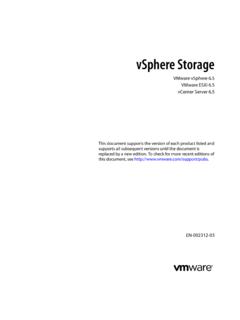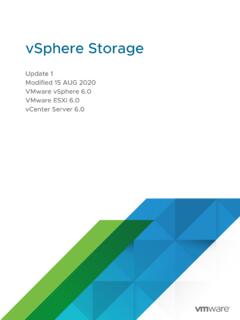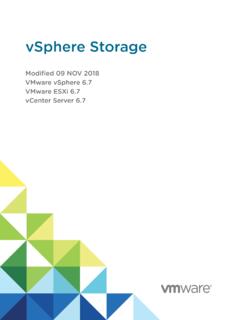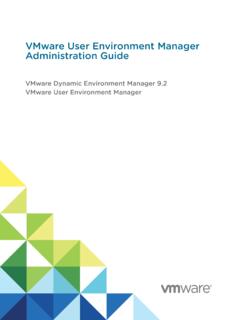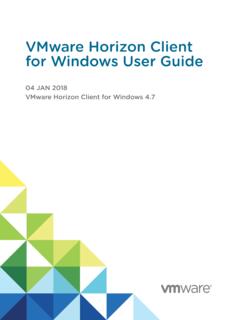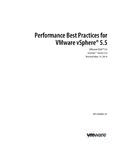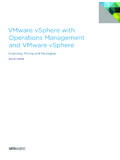Transcription of vSphere Networking - VMware vSphere 6
1 vSphere NetworkingUpdate 2 Modified on 19 April 2018 VMware vSphere ESXi Server NetworkingVMware, Inc. 2 You can find the most up-to-date technical documentation on the VMware website at: you have comments about this documentation, submit your feedback 2009 2018 VMware , Inc. All rights reserved. Copyright and trademark , Hillview Alto, CA vSphere Networking 10 1 Introduction to Networking 11 Networking Concepts Overview 11 Network Services in ESXi 13 VMware ESXi Dump Collector Support 13 2 Setting Up Networking with vSphere Standard Switches 15vSphere Standard Switches 15 Create a vSphere Standard Switch 17 Port Group Configuration for Virtual Machines 18 Add a Virtual Machine Port Group 19 Edit a Standard Switch Port Group 20 Remove a Port Group from a vSphere Standard Switch 21vSphere Standard Switch Properties 21 Change the Size of the MTU on a vSphere Standard Switch 22 Change the Speed of a
2 Physical Adapter 22 Add and Team Physical Adapters in a vSphere Standard Switch 22 View the Topology Diagram of a vSphere Standard Switch 23 3 Setting Up Networking with vSphere Distributed Switches 25vSphere Distributed Switch Architecture 25 Create a vSphere Distributed Switch 29 Upgrade a vSphere Distributed Switch to a Later Version 30 Edit General and Advanced vSphere Distributed Switch Settings 32 Managing Networking on Multiple Hosts on a vSphere Distributed Switch 33 Tasks for Managing Host Networking on a vSphere Distributed Switch 34 Add Hosts to a vSphere Distributed Switch 35 Configure Physical Network Adapters on a vSphere Distributed Switch 37 Migrate VMkernel Adapters to a vSphere Distributed Switch 38 Create a VMkernel Adapter on a vSphere Distributed Switch 39 Migrate Virtual Machine Networking to the vSphere Distributed Switch 41 Use a Host as a Template to Create a Uniform Networking Configuration on a vSphereDistributed Switch 42 Remove Hosts from a vSphere Distributed Switch 44 Managing Networking on Host Proxy Switches 45 Migrate Network Adapters on a Host to a vSphere Distributed Switch 45 Migrate a VMkernel Adapter
3 On a Host to a vSphere Standard Switch 46 VMware , Inc. 3 Assign a Physical NIC of a Host to a vSphere Distributed Switch 47 Remove a Physical NIC from a vSphere Distributed Switch 47 Removing NICs from Active Virtual Machines 47 Distributed Port Groups 48 Add a Distributed Port Group 48 Edit General Distributed Port Group Settings 51 Configure Overriding Networking Policies on Port Level 52 Remove a Distributed Port Group 53 Working with Distributed Ports 53 Monitor the State of Distributed Ports 53 Configure Distributed Port Settings 54 Configuring Virtual Machine Networking on a vSphere Distributed Switch 54 Migrate Virtual
4 Machines to or from a vSphere Distributed Switch 55 Connect an Individual Virtual Machine to a Distributed Port Group 55 Topology Diagrams of a vSphere Distributed Switch in the vSphere Web Client 56 View the Topology of a vSphere Distributed Switch 56 View the Topology of a Host Proxy Switch 58 4 Setting Up VMkernel Networking 59 VMkernel Networking Layer 60 View Information About VMkernel Adapters on a Host 62 Create a VMkernel Adapter on a vSphere Standard Switch 63 Create a VMkernel Adapter on a Host Associated with a vSphere Distributed Switch 65 Edit a VMkernel Adapter Configuration 67 Overriding the Default Gateway of a VMkernel Adapter 68 Configure the VMkernel Adapter Gateway by Using esxcli Commands 69 View TCP/IP Stack Configuration on a Host 70 Change the Configuration of a TCP/IP Stack on a Host 70 Create a Custom TCP/IP Stack 71 Remove a VMkernel Adapter 71 5 LACP Support on a vSphere Distributed Switch 73 Convert to the Enhanced LACP Support on a vSphere Distributed Switch 75 LACP Teaming and Failover Configuration for Distributed Port Groups 77 Configure a Link Aggregation Group to Handle the Traffic for Distributed Port Groups 77
5 Create a Link Aggregation Group 78 Set a Link Aggregating Group as Standby in the Teaming and Failover Order of Distributed PortGroups 79 Assign Physical NICs to the Ports of the Link Aggregation Group 80 Set the Link Aggregation Group as Active in the Teaming and Failover Order of the DistributedPort Group 81 Edit a Link Aggregation Group 82vSphere NetworkingVMware, Inc. 4 Enable LACP Support on an Uplink Port Group 82 Limitations of the LACP Support on a vSphere Distributed Switch 83 6 Backing Up and Restoring Networking Configurations 85 Backing Up and Restoring a vSphere Distributed Switch Configuration 85 Export vSphere Distributed Switch Configurations 85 Import a vSphere Distributed Switch Configuration 86 Restore a vSphere Distributed Switch Configuration 87 Export, Import.
6 And Restore vSphere Distributed Port Group Configurations 88 Export vSphere Distributed Port Group Configurations 88 Import a vSphere Distributed Port Group Configuration 88 Restore a vSphere Distributed Port Group Configuration 89 7 Rollback and Recovery of the Management Network 90vSphere Networking Rollback 90 Disable Network Rollback 91 Disable Network Rollback by Using the vCenter Server Configuration File 92 Resolve Errors in the Management Network Configuration on a vSphere Distributed Switch 92 8 Networking Policies 94 Applying Networking Policies on a vSphere Standard or Distributed Switch 95 Configure Overriding Networking Policies on Port Level 96 Teaming and Failover Policy 97 Load Balancing Algorithms Available for Virtual Switches 99 Configure NIC Teaming, Failover, and Load Balancing on a vSphere Standard Switch orStandard Port Group 103 Configure NIC Teaming, Failover.
7 And Load Balancing on a Distributed Port Group orDistributed Port 105 VLAN Policy 107 Configure VLAN Tagging on a Distributed Port Group or Distributed Port 108 Configure VLAN Tagging on an Uplink Port Group or Uplink Port 109 Security Policy 109 Configure the Security Policy for a vSphere Standard Switch or Standard Port Group 110 Configure the Security Policy for a Distributed Port Group or Distributed Port 111 Traffic Shaping Policy 112 Configure Traffic Shaping for a vSphere Standard Switch or Standard Port Group 113 Edit the Traffic Shaping Policy on a Distributed Port Group or Distributed Port 114 Resource Allocation Policy 115 Edit the Resource Allocation Policy on a Distributed Port Group 116 Edit the Resource Allocation Policy on a Distributed Port 116 Monitoring Policy 117 Enable or Disable NetFlow Monitoring on a Distributed Port Group or Distributed Port 117vSphere NetworkingVMware, Inc.
8 5 Traffic Filtering and Marking Policy 118 Traffic Filtering and Marking on a Distributed Port Group or Uplink Port Group 118 Traffic Filtering and Marking on a Distributed Port or Uplink Port 126 Qualifying Traffic for Filtering and Marking 134 Manage Policies for Multiple Port Groups on a vSphere Distributed Switch 137 Port Blocking Policies 142 Edit the Port Blocking Policy for a Distributed Port Group 142 Edit the Blocking Policy for a Distributed Port or Uplink Port 142 9 Isolating Network Traffic by Using VLANs 144 VLAN Configuration 144 Private VLANs 145 Create a Private VLAN 145 Remove a Primary Private VLAN 146 Remove a Secondary Private VLAN 146 10 Managing Network Resources 148 DirectPath I/O 148 Enable Passthrough for a Network Device on a Host 149 Configure a PCI Device on a Virtual Machine 150 Enable DirectPath I/O with vMotion on a Virtual Machine 150 Single Root I/O Virtualization (SR-IOV)
9 151SR-IOV Support 152SR-IOV Component Architecture and Interaction 154vSphere and Virtual Function Interaction 156 DirectPath I/O vs SR-IOV 157 Configure a Virtual Machine to Use SR-IOV 157 Networking Options for the Traffic Related to an SR-IOV Enabled Virtual Machine 160 Using an SR-IOV Physical Adapter to Handle Virtual Machine Traffic 160 Enabling SR-IOV by Using Host Profiles or an ESXCLI Command 161 Virtual Machine That Uses an SR-IOV Virtual Function Fails to Power On Because the Host IsOut of Interrupt Vectors 163 Remote Direct Memory Access for Virtual Machines 164 PVRDMA Support 164 Configure an ESXi Host for PVRDMA 165 Assign a PVRDMA Adapter to a Virtual Machine 166 Network Requirements for RDMA over Converged Ethernet 167 Jumbo Frames 168 Enable Jumbo Frames on a vSphere Distributed Switch 168 Enable Jumbo Frames on a vSphere Standard Switch 168 Enable Jumbo Frames for a VMkernel Adapter 169 Enable Jumbo Frame Support on a Virtual Machine 169vSphere NetworkingVMware, Inc.
10 6 TCP Segmentation Offload 170 Enable or Disable Software TSO in the VMkernel 170 Determine Whether TSO Is Supported on the Physical Network Adapters on an ESXi Host 171 Enable or Disable TSO on an ESXi Host 171 Determine Whether TSO Is Enabled on an ESXi Host 172 Enable or Disable TSO on a Linux Virtual Machine 172 Enable or Disable TSO on

